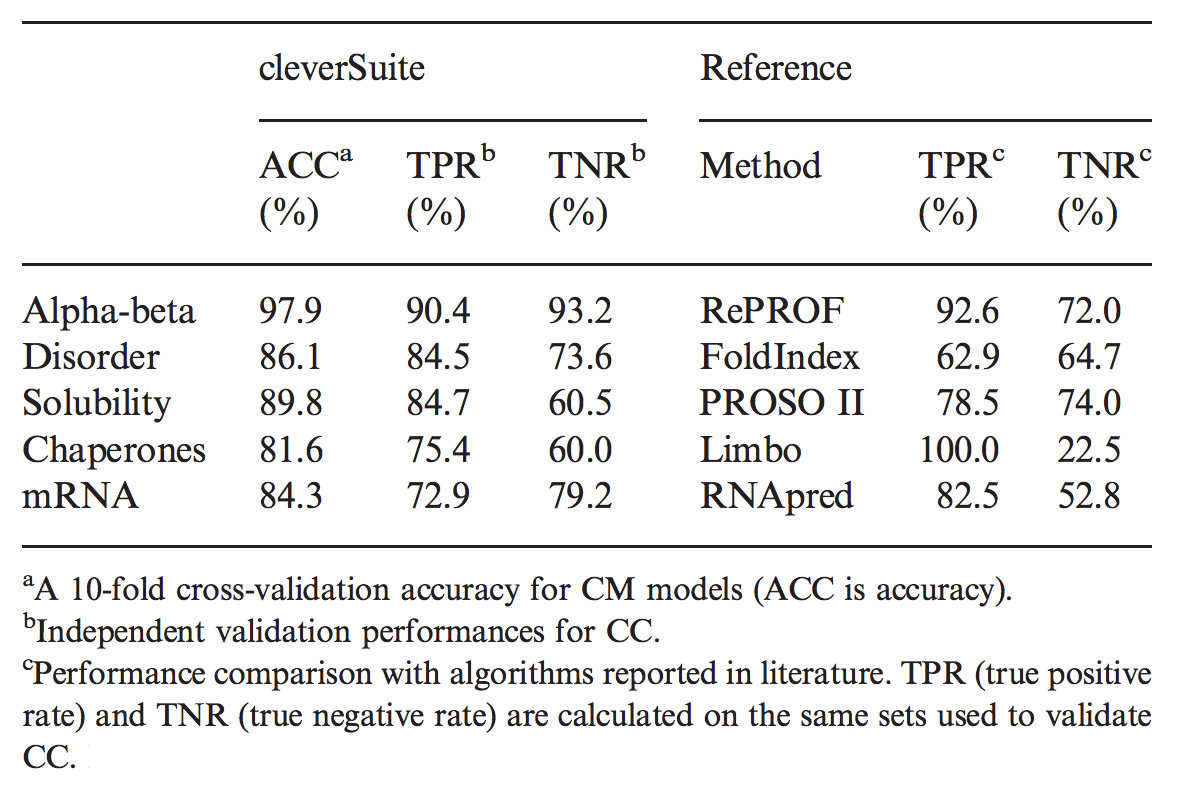
cleverMachine and cleverClassifier models available to the community.
CM |
CC |
Description |
|
|---|---|---|---|
| Alpha-helix vs. beta-sheet (Bernstein) | by Petr Klus | ||
| link | - | Alpha-helix vs. beta-sheet model/training | run classifier |
| - | link | Alpha-helix rich proteins vs. alphabeta model | |
| - | link | Beta sheet rich proteins vs. alphabeta model | |
| mRNA-binding interactome in H. sapiens (Castello) | by Petr Klus | ||
| link | - | mRNA-binding interactome in H. sapiens (Castello) training/model | run classifier |
| - | link | mRNA binding proteins (Baltz) vs. mRNA binding proteins (Castello) | |
| - | link | proteins not binding mRNA (Shazman) vs. mRNA binding proteins (Castello) | |
| Structurally disordered proteins | by Petr Klus | ||
| link | - | Structurally disordered proteins training/model (Sickmeier) | run classifier |
| - | link | Prions vs. disorder model (Alberti) | |
| - | link | Structured proteins vs. disorder model (Tartaglia) | |
| E. coli solubility | by Petr Klus | ||
| link | - | E. coli solubility model/training (Niwa) | run classifier |
| - | link | Independently folding proteins (Tartaglia) vs. solubility model | |
| - | link | Chaperone-dependent proteins vs. solubility model | |
| Chaperone-dependent proteins | by Petr Klus | ||
| link | - | Chaperone-dependent proteins model/training (Kerner) | run classifier |
| - | link | DnaK/GroEL dependent proteins vs. chaperone model | |
| - | link | Independently folding proteins (Tartaglia) vs. chaperone model | |
| E. Coli and H. Sapiens full proteome analysis | by Petr Klus | ||
| link | - | E. Coli and H. Sapiens full proteome analysis | |
multiCleverMachine models available to the community.
multiCM |
Description |
|
|---|---|---|
| link | Physico-chemical properties of proteins involved in cancer and central-nervous-system diseases | run classifier |
| link | S. cerevisiae chaperone substrates | run classifier |
| link | Low solubility and high solubility proteins in H. sapiens, M. musculus and S. cerevisiae | run classifier |
| link | Analysis of daf-2 insoluble fractions in C. elegans | run classifier |
| link | Analysis of hsf-1 insoluble fractions in C. elegans | run classifier |
The authors listed are usually the CM/CC users - they may not be the authors of the submitted datasets. Please contact the respective authors for more details.
cleverSuite performances at a glance

References
Baltz, A.G. et al. (2012) The mRNA-Bound Proteome and Its Global Occupancy Profile on Protein-Coding Transcripts. Molecular Cell, 46, 674–690.
Castello, A. et al. (2012) Insights into RNA Biology from an Atlas of Mammalian mRNA-Binding Proteins. Cell, 149, 1393–1406
Shazman,S. and Mandel-Gutfreund,Y. (2008) Classifying RNA-Binding Proteins Based on Electrostatic Properties. PLoS Comput Biol, 4, e1000146.
Bernstein,F.C. et al. (1977) The Protein Data Bank: a computer-based archival file for macromolecular structures. J. Mol. Biol., 112, 535–542
Sickmeier,M. et al. (2007) DisProt: the database of disordered proteins. Nucleic Acids Res., 35, D786–D793.
Alberti,S. et al. (2009) A systematic survey identifies prions and illuminates sequence features of prionogenic proteins. Cell, 137, 146–158.
Tartaglia,G.G. and Vendruscolo,M. (2010) Proteome-level interplay between folding and aggregation propensities of proteins. J. Mol. Biol., 402, 919–928.
Niwa,T. et al. (2009) Bimodal protein solubility distribution revealed by an aggregation analysis of the entire ensemble of Escherichia coli proteins. Proc. Natl Acad. Sci. USA, 106, 4201–4206.
Kerner,M.J. et al. (2005) Proteome-wide analysis of chaperonin-dependent protein folding in Escherichia coli. Cell, 122, 209–20.